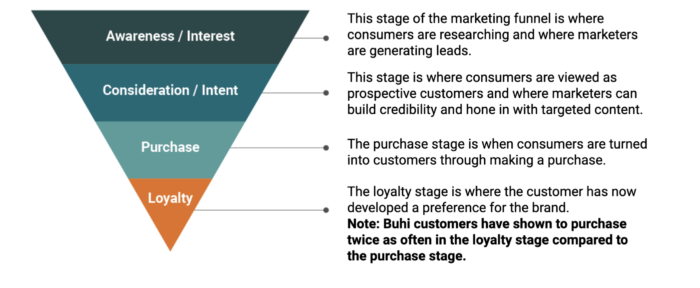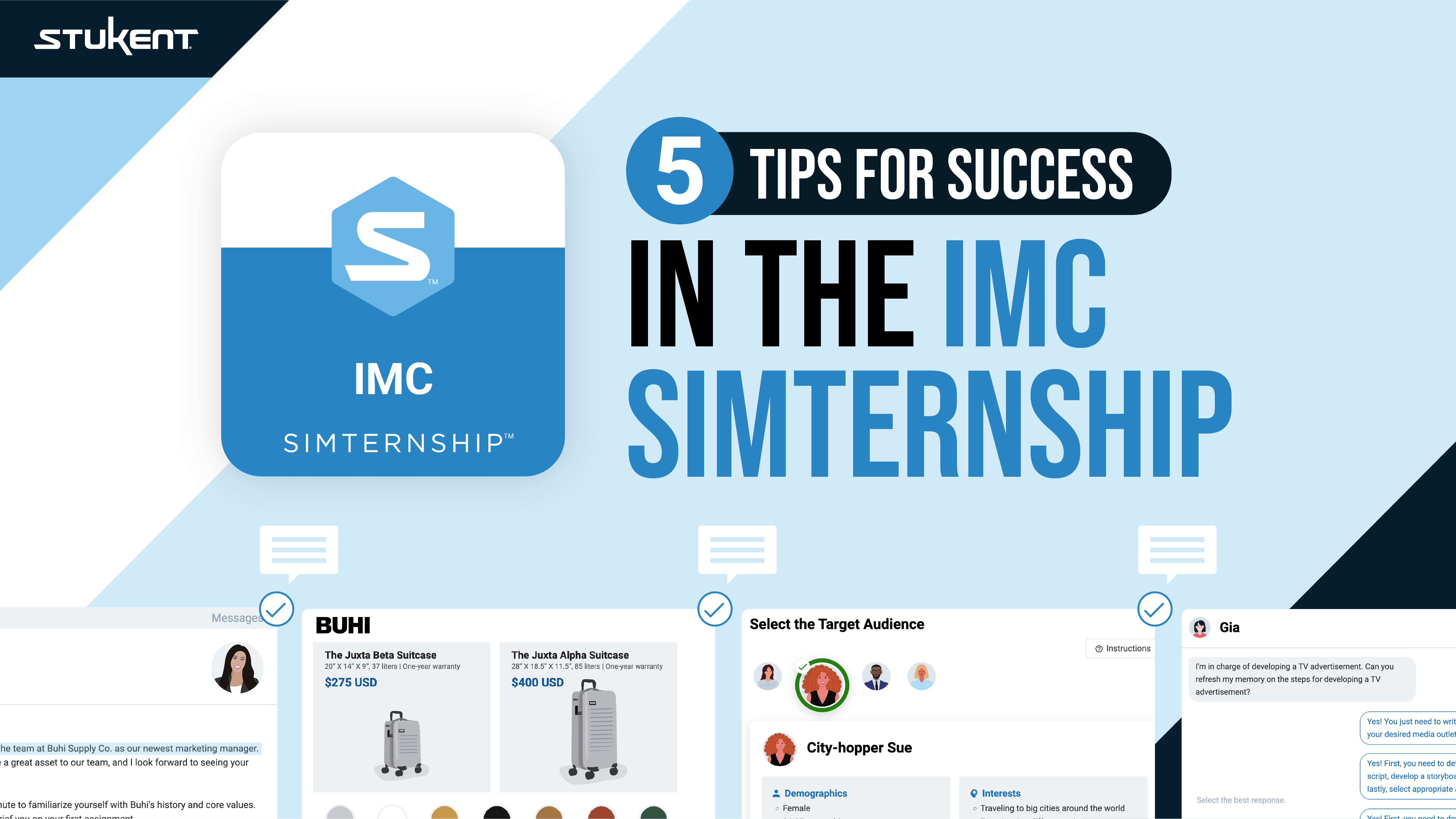The Integrated Marketing Communications (IMC) Simternship™ provides students with hands-on experience as a marketing manager at Buhi Supply Co., a simulated company specializing in smart luggage.
“I found the Simternship itself to be highly interactive and a fun way to learn the material,” shared Kyle Knitter, a student at the University of Wisconsin-Stout. “I felt that my actions in the Simternship were truly impacting the company I was managing. This experience has given me confidence that I will be able to perform well in my future career in advertising and marketing. The Simternship’s engaging and easy-to-use platform, coupled with its valuable knowledge, made for a highly productive and essential learning experience.”
Over the course of eight rounds, students will develop and refine marketing campaigns aimed at increasing the company’s reach, with a focus on targeting specific audiences at various stages of the marketing funnel. Here are five tips to help students excel in the IMC Simternship.
Tip 1: Know When Your Target Audiences Are Buying
A key to success in the IMC Simternship is understanding the purchasing patterns of your target audiences. The simulation provides resources that outline when each persona will likely make a purchase. For example, if you’re in Year 1, Quarter 1, and your target audience is City-hopper Sue, you need to know that she will likely buy during this quarter.
This knowledge allows you to strategize effectively. If you know that a particular audience is more inclined to purchase in a specific quarter, you can tailor your marketing efforts to target them at that time. It’s not just about when they are buying, but also why. Consider the reasons behind their purchasing patterns. Perhaps City-hopper Sue is looking to escape the cold weather with a trip to a warmer destination. Understanding these nuances can help you create more resonant and effective campaigns.

Tip 2: Prioritize Campaigns for Immediate Purchasers
Your first order of business should be to create campaigns for those audiences that are ready to purchase immediately. Capturing revenue from these audiences right away is crucial. For instance, if City-hopper Sue is in the buying phase in Quarter 1, your campaign should focus on her, targeting purchasing or loyalty.
After securing immediate purchasers, your next step is to build up the marketing funnel for other audiences. For example, if Back-to-School Mindy is set to purchase in Quarter 2, you’ll want to focus on moving her from the awareness stage to the consideration stage in Quarter 1. This way she’ll be ready to make a purchase by the time Quarter 2 rolls around.
Tip 3: Tailor Your Messaging
A significant aspect of any successful marketing campaign is tailored messaging. Your message needs to resonate with your target audience, providing them with the right information that aligns with their needs and preferences. In the IMC Simternship, you’ll use positioning statements to achieve this.
![An image from the simulation. It shows a positioning statement activity that asks students to fill in the blanks, as follows. Target Audience: City-hopper Sue. Campaign Objective: Consideration/Intent. Percentage of Target Audience within the Chosen Funnel Stage: 19%. For [blank] Juxta smart luggage is the luggage that best delivers a [blank] design because Juxta smart luggage and only Juxta smart luggage allows you to [blank].](https://www.stukent.com/wp-content/uploads/2024/04/Screen-Shot-2024-04-12-at-3.07.17-PM-700x176.png)
Think of yourself as the strategist, guiding your team to create content that speaks directly to your target persona. For example, if you’re targeting City-hopper Sue, your messaging should highlight features of the smart luggage that appeal to her lifestyle, such as durability for frequent travel or smart technology for convenience.
Tip 4: Align Channels with the Sales Funnel
Choosing the right channels for your campaign is crucial. Your selection should align with your campaign’s goal and the stage of the sales funnel you’re targeting. The simulation provides a list of channels for promotion, and the resources section offers guidance on which channels are most effective for each stage of the funnel.

For instance, if you’re focusing on loyalty for City-hopper Sue, you might choose channels that are known for fostering long-term customer relationships, such as email marketing or loyalty programs. On the other hand, if you’re aiming to increase awareness among a new audience, social media or online advertising might be more appropriate.
Tip 5: Test and Review
The IMC Simternship is not just about executing campaigns; it’s also about learning from them. Testing different strategies and reviewing the results is a vital part of the process. Keep a close eye on the performance of your campaigns, and don’t be afraid to make adjustments based on what you learn.
For example, if a campaign targeting City-hopper Sue isn’t yielding the expected results, you might need to revisit your messaging or channel selection. Maybe the messaging isn’t resonating as well as you thought, or perhaps a different channel would be more effective in reaching her. Use the data and feedback from each round to refine your approach and improve the effectiveness of your marketing efforts.
Success in the IMC Simternship requires a combination of strategic planning, audience understanding, tailored messaging, channel alignment, and continuous learning. By following these five tips, students can navigate the challenges of marketing management and make the most of this hands-on learning experience.
Selling Your Simternship Experience
Completing the IMC Simternship will give you valuable marketing skills that can significantly enhance your resume and LinkedIn profile. On your resume, emphasize your hands-on experience with strategic marketing management, campaign development, audience analysis, and data-driven decision-making. Be sure to specify any measurable achievements that demonstrate your impact on the simulated business’ success, such as campaign goals met or budget efficiencies.
On your LinkedIn profile, add the Simternship under the certifications section. Include a brief description of your role and responsibilities, along with any notable accomplishments from the Simternship.
To learn about Stukent’s® first-in-the-world Simternships and courseware and to get FREE instructor access to Stukent materials, visit our website.






